CN Tower
The CN Tower (French: Tour CN) is a 553.3 m-high (1,815.3 ft) concrete communications and observation tower in Toronto, Ontario, Canada. Completed in 1976, it is located in downtown Toronto, built on the former Railway Lands. Its name "CN" referred to Canadian National, the railway company that built the tower. Following the railway's decision to divest non-core freight railway assets prior to the company's privatization in 1995, it transferred the tower to the Canada Lands Company, a federal Crown corporation responsible for the government's real estate portfolio.
The CN Tower held the record for the world's tallest free-standing structure for 32 years, from 1975 until 2007, when it was surpassed by the Burj Khalifa, and was the world's tallest tower until 2009 when it was surpassed by the Canton Tower. It is currently the tenth-tallest free-standing structure in the world and remains the tallest free-standing structure ...Read more
The CN Tower (French: Tour CN) is a 553.3 m-high (1,815.3 ft) concrete communications and observation tower in Toronto, Ontario, Canada. Completed in 1976, it is located in downtown Toronto, built on the former Railway Lands. Its name "CN" referred to Canadian National, the railway company that built the tower. Following the railway's decision to divest non-core freight railway assets prior to the company's privatization in 1995, it transferred the tower to the Canada Lands Company, a federal Crown corporation responsible for the government's real estate portfolio.
The CN Tower held the record for the world's tallest free-standing structure for 32 years, from 1975 until 2007, when it was surpassed by the Burj Khalifa, and was the world's tallest tower until 2009 when it was surpassed by the Canton Tower. It is currently the tenth-tallest free-standing structure in the world and remains the tallest free-standing structure on land in the Western Hemisphere. In 1995, the CN Tower was declared one of the modern Seven Wonders of the World by the American Society of Civil Engineers. It also belongs to the World Federation of Great Towers.
It is a signature icon of Toronto's skyline and attracts more than two million international visitors annually. It houses several observation decks, a revolving restaurant at some 350 metres (1,150 ft), and an entertainment complex.
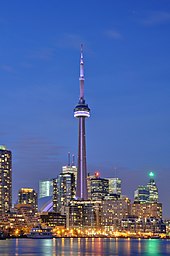 CN Tower from the Toronto Islands
CN Tower from the Toronto IslandsThe original concept of the CN Tower was first conceived in 1968 when the Canadian National Railway wanted to build a large television and radio communication platform to serve the Toronto area, and to demonstrate the strength of Canadian industry and CN in particular. These plans evolved over the next few years, and the project became official in 1972.
The tower would have been part of Metro Centre (see CityPlace), a large development south of Front Street on the Railway Lands, a large railway switching yard that was being made redundant after the opening of the MacMillan Yard north of the city in 1965 (then known as Toronto Yard). Key project team members were NCK Engineering as structural engineer; John Andrews Architects; Webb, Zerafa, Menkes, Housden Architects; Foundation Building Construction; and Canron (Eastern Structural Division).[1][2][3]
As Toronto grew rapidly during the late 1960s and early 1970s, multiple skyscrapers were constructed in the downtown core, most notably First Canadian Place, which has Bank of Montreal's head offices. The reflective nature of the new buildings reduced the quality of broadcast signals, requiring new, higher antennas that were at least 300 m (980 ft) tall. The radio wire is estimated to be 102 metres (335 ft) long in 44 pieces, the heaviest of which weighs around 8 tonnes (8.8 short tons; 7.9 long tons).[4]
At the time, most data communications took place over point-to-point microwave links, whose dish antennas covered the roofs of large buildings. As each new skyscraper was added to the downtown, former line-of-sight links were no longer possible. CN intended to rent "hub" space for microwave links, visible from almost any building in the Toronto area.
The original plan for the tower envisioned a tripod consisting of three independent cylindrical "pillars" linked at various heights by structural bridges. Had it been built, this design would have been considerably shorter, with the metal antenna located roughly where the concrete section between the main level and the SkyPod lies today. As the design effort continued, it evolved into the current design with a single continuous hexagonal core to the SkyPod, with three support legs blended into the hexagon below the main level, forming a large Y-shape structure at the ground level.[3][5]
The idea for the main level in its current form evolved around this time, but the Space Deck (later renamed SkyPod) was not part of the plans until later. One engineer in particular felt that visitors would feel the higher observation deck would be worth paying extra for, and the costs in terms of construction were not prohibitive. Also around this time, it was realized that the tower could become the world's tallest free-standing structure to improve signal quality and attract tourists, and plans were changed to incorporate subtle modifications throughout the structure to this end.[3][5]
Construction Map of the area immediately surrounding CN Tower
Map of the area immediately surrounding CN TowerThe CN Tower was built by Canada Cement Company (also known as the Cement Foundation Company of Canada at the time),[6] a subsidiary of Sweden's Skanska, a global project-development and construction group.
Construction began on February 6, 1973, with massive excavations at the tower base for the foundation. By the time the foundation was complete, 56,000 t (62,000 short tons; 55,000 long tons) of earth and shale were removed to a depth of 15 m (49.2 ft) in the centre, and a base incorporating 7,000 m3 (9,200 cu yd) of concrete with 450 t (496 short tons; 443 long tons) of rebar and 36 t (40 short tons; 35 long tons) of steel cable had been built to a thickness of 6.7 m (22 ft). This portion of the construction was fairly rapid, with only four months needed between the start and the foundation being ready for construction on top.[5]
To create the main support pillar, workers constructed a hydraulically raised slipform at the base. This was a fairly unprecedented engineering feat on its own, consisting of a large metal platform that raised itself on jacks at about 6 m (20 ft) per day as the concrete below set. Concrete was poured Monday to Friday (not continuously) by a small team of people until February 22, 1974, at which time it had already become the tallest structure in Canada, surpassing the recently built Inco Superstack in Sudbury, built using similar methods.
The tower contains 40,500 m3 (53,000 cu yd) of concrete, all of which was mixed on-site in order to ensure batch consistency. Through the pour, the vertical accuracy of the tower was maintained by comparing the slip form's location to massive plumb bobs hanging from it, observed by small telescopes from the ground. Over the height of the tower, it varies from true vertical accuracy by only 29 mm (1.1 in).[3][5]
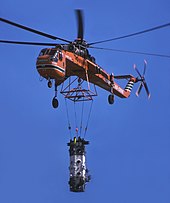 Skycrane "Olga" lifting antenna segment
Skycrane "Olga" lifting antenna segmentIn August 1974, construction of the main level commenced. Using 45 hydraulic jacks attached to cables strung from a temporary steel crown anchored to the top of the tower, twelve giant steel and wooden bracket forms were slowly raised, ultimately taking about a week to crawl up to their final position. These forms were used to create the brackets that support the main level, as well as a base for the construction of the main level itself. The Space Deck (currently named SkyPod) was built of concrete poured into a wooden frame attached to rebar at the lower level deck, and then reinforced with a large steel compression band around the outside.[5]
While still under construction, the CN Tower officially became the world's tallest free-standing structure on March 31, 1975.[7]
The antenna was originally to be raised by crane as well, but, during construction, the Sikorsky S-64 Skycrane helicopter became available when the United States Army sold one to civilian operators. The helicopter, named "Olga", was first used to remove the crane, and then flew the antenna up in 36 sections.
The flights of the antenna pieces were a minor tourist attraction of their own, and the schedule was printed in local newspapers. Use of the helicopter saved months of construction time, with this phase taking only three and a half weeks instead of the planned six months. The tower was topped-off on April 2, 1975, after 26 months of construction, officially capturing the height record from Moscow's Ostankino Tower, and bringing the total mass to 118,000 t (130,000 short tons; 116,000 long tons).
Two years into the construction, plans for Metro Centre were scrapped, leaving the tower isolated on the Railway Lands in what was then a largely abandoned light-industrial space. This caused serious problems for tourists to access the tower. Ned Baldwin, project architect with John Andrews, wrote at the time that "All of the logic which dictated the design of the lower accommodation has been upset," and that "Under such ludicrous circumstances Canadian National would hardly have chosen this location to build."[8]
Phases of construction
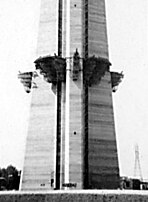




 View of Toronto's Financial District from the CN Tower in 2008
View of Toronto's Financial District from the CN Tower in 2008The CN Tower opened on June 26, 1976.[9] The construction costs of approximately CA$63 million ($287 million in 2021 dollars)[10] were repaid in fifteen years.[11]
From the mid-1970s to the mid-1980s, the CN Tower was practically the only development along Front Street West; it was still possible to see Lake Ontario from the foot of the CN Tower due to the expansive parking lots and lack of development in the area at the time. As the area around the tower was developed, particularly with the completion of the Metro Toronto Convention Centre (north building) in 1984 and SkyDome in 1989 (renamed Rogers Centre in 2005), the former Railway Lands were redeveloped and the tower became the centre of a newly developing entertainment area. Access was greatly improved with the construction of the SkyWalk in 1989, which connected the tower and SkyDome to the nearby Union Station railway and subway station, and, in turn, to the city's Path underground pedestrian system. By the mid-1990s, it was the centre of a thriving tourist district. The entire area continues to be an area of intense building, notably a boom in condominium construction in the first quarter of the 21st century, as well as the 2013 opening of the Ripley's Aquarium by the base of the tower.[12][3][5]
Early yearsWhen the CN Tower opened in 1976, there were three public observation points: the SkyPod (then known as the Space Deck) that stands at 447 m (1,467 ft), the Indoor Observation Level (later named Indoor Lookout Level) at 346 m (1,135 ft), and the Outdoor Observation Terrace (at the same level as the Glass Floor) at 342 m (1,122 ft).[12][5] One floor above the Indoor Observation Level was the Top of Toronto Restaurant, which completed a revolution once every 72 minutes.[13]
The tower would garner worldwide media attention when stuntman Dar Robinson jumped off the CN Tower on two occasions in 1979 and 1980. The first was for a scene from the movie Highpoint, in which Robinson received CA$250,000 ($885,000 in 2021 dollars)[10] for the stunt. The second was for a personal documentary. The first stunt had him use a parachute which he deployed three seconds before impact with the ground, while the second one used a wire decelerator attached to his back.[14]
On June 26, 1986, the tenth anniversary of the tower's opening, high-rise firefighting and rescue advocate Dan Goodwin, in a sponsored publicity event, used his hands and feet to climb the outside of the tower, a feat he performed twice on the same day. Following both ascents, he used multiple rappels to descend to the ground.[15]
From 1985 to 1992, the CN Tower basement level hosted the world's first flight simulator ride, Tour of the Universe. The ride was replaced in 1992 with a similar attraction entitled "Space Race." It was later dismantled and replaced by two other rides in 1998 and 1999.
The 1990s and 2000sA glass floor at an elevation of 342 m (1,122 ft) was installed in 1994.[5] Canadian National Railway sold the tower to Canada Lands Company prior to privatizing the company in 1995, when it divested all operations not directly related to its core freight shipping businesses. The tower's name and wordmark were adjusted to remove the CN railways logo, and the tower was renamed Canada's National Tower (from Canadian National Tower),[16] though the tower is commonly called the CN Tower.
Further changes were made from 1997 to January 2004: TrizecHahn Corporation managed the tower and instituted several expansion projects including a CA$26 million entertainment expansion, the 1997 addition of two new elevators (to a total of six) and the consequential relocation of the staircase from the north side leg to inside the core of the building, a conversion that also added nine stairs to the climb. TrizecHahn also owned the Willis Tower (Sears Tower at the time) in Chicago approximately at the same time.
In 2007, light-emitting diode (LED) lights replaced the incandescent lights that lit the CN Tower at night. This was done to take advantage of the cost savings of LED lights over incandescent lights. The colour of the LED lights can change, compared to the constant white colour of the incandescent lights. On September 12, 2007, Burj Khalifa, then under construction and known as Burj Dubai, surpassed the CN Tower as the world's tallest free-standing structure on land.[17] In 2008, glass panels were installed in one of the CN Tower elevators, which established a world record (346 m) for highest glass floor panelled elevator in the world.
2010s: EdgeWalk EdgeWalk atop the main pod
EdgeWalk atop the main podOn August 1, 2011, the CN Tower opened the EdgeWalk, an amusement in which thrill-seekers can walk on and around the roof of the main pod of the tower at 356 m (1,168.0 ft), which is directly above the 360 Restaurant.[18] It is the world's highest full-circle, hands-free walk. Visitors are tethered to an overhead rail system and walk around the edge of the CN Tower's main pod above the 360 Restaurant on a 1.5-metre (4.9 ft) metal floor.[19] The attraction is closed throughout the winter and during periods of electrical storms and high winds.
One of the notable guests who visited EdgeWalk was Canadian comedian Rick Mercer, featured as the first episode of the ninth season of his CBC Television news satire show, Rick Mercer Report. There, he was accompanied by Canadian pop singer Jann Arden. The episode first aired on April 10, 2013.[20]
Pan Am GamesThe tower and surrounding areas were prominent in the 2015 Pan American Games production. In the opening ceremony, a pre-recorded segment featured track-and-field athlete Bruny Surin passing the flame to sprinter Donovan Bailey on the EdgeWalk and parachuting into Rogers Centre. A fireworks display off the tower concluded both the opening and closing ceremonies.
Canada 150On July 1, 2017, as part of the nationwide celebrations for Canada 150, which celebrated the 150th anniversary of Canadian Confederation, fireworks were once again shot from the tower in a five-minute display coordinated with the tower lights and music broadcast on a local radio station.
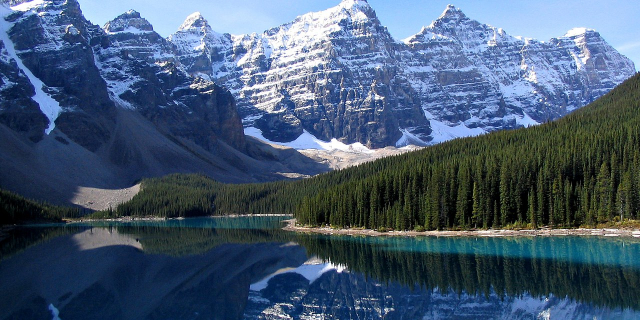

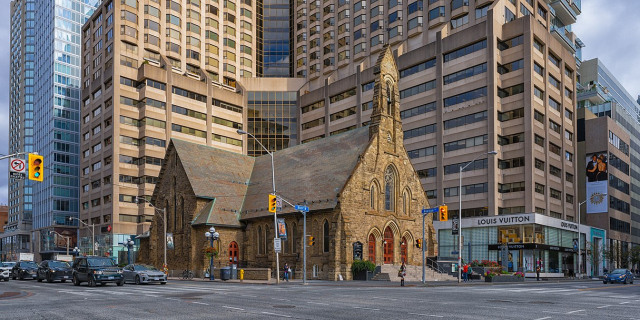

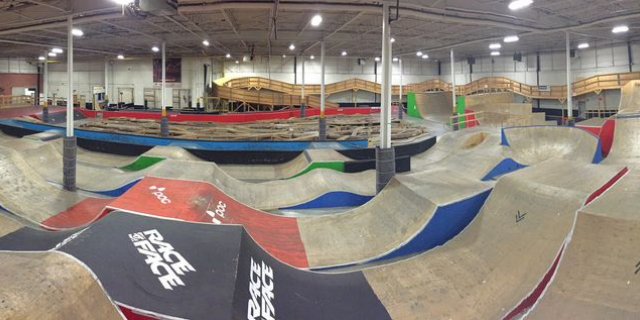






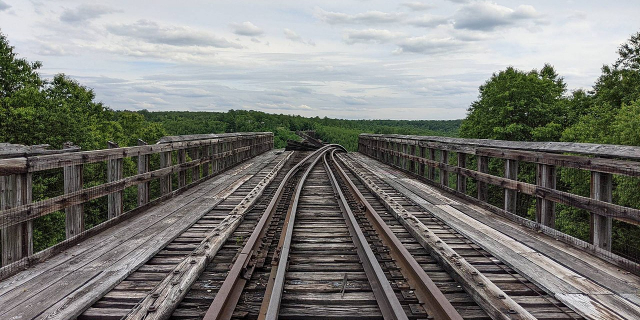

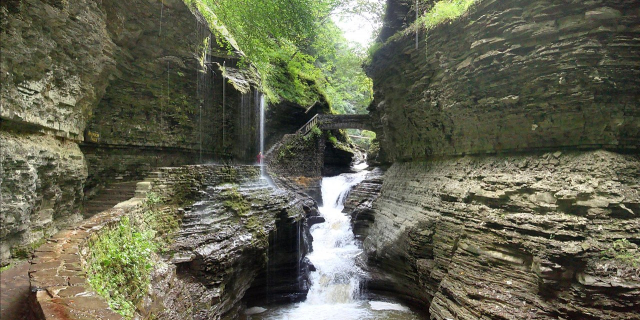








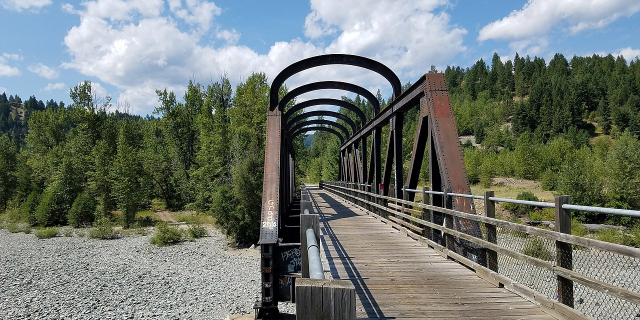




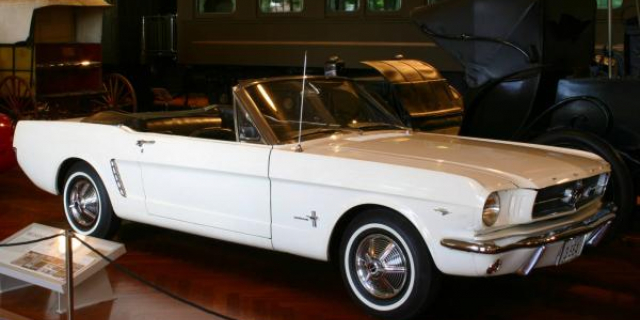
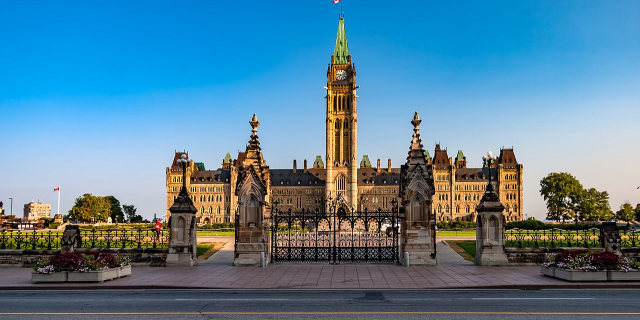

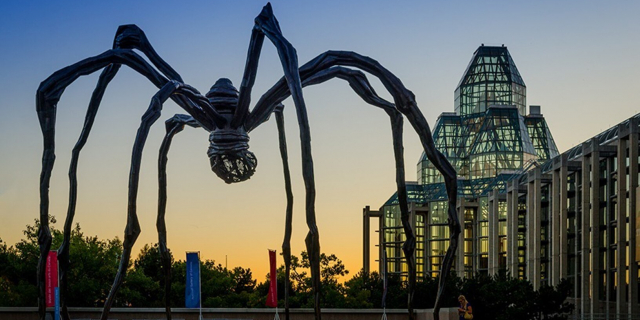
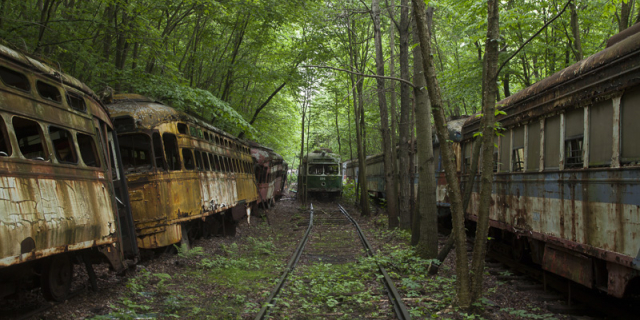
Add new comment